-
This community needs YOUR help today. We rely 100% on Supporting Memberships to fund our efforts. With the ever increasing fees of everything, we need help. We need more Supporting Members, today. Please invest back into this community. I will ship a few decals too in addition to all the account perks you get.

Sign up here: https://www.muzzleloadingforum.com/account/upgrades -
Friends, our 2nd Amendment rights are always under attack and the NRA has been a constant for decades in helping fight that fight.
We have partnered with the NRA to offer you a discount on membership and Muzzleloading Forum gets a small percentage too of each membership, so you are supporting both the NRA and us.
Use this link to sign up please; https://membership.nra.org/recruiters/join/XR045103
You are using an out of date browser. It may not display this or other websites correctly.
You should upgrade or use an alternative browser.
You should upgrade or use an alternative browser.
Building a Hawkin style half stock
- Thread starter Drago
- Start date

Help Support Muzzleloading Forum:
This site may earn a commission from merchant affiliate
links, including eBay, Amazon, and others.
jdkerstetter
69 Cal.
- Joined
- Feb 15, 2012
- Messages
- 3,029
- Reaction score
- 7
Here you go: http://www.lr-rpl.com/index.php?op...000-900dt-1000dt&catid=38:lar-locks&Itemid=61
A little bigger than the Manton and no "tit" on the back.
Enjoy, J.D.
A little bigger than the Manton and no "tit" on the back.
Enjoy, J.D.
Last edited by a moderator:
jdkerstetter
69 Cal.
- Joined
- Feb 15, 2012
- Messages
- 3,029
- Reaction score
- 7
Yes, it can be confusing, however Track is now calling this one the Late English as L&R does....in the description they say it was "Formerly called the Ashmore".
The Manton is the slightly smaller lock with the tit on the tail and a different style pan.
Both are good locks.
Enjoy, J.D.
The Manton is the slightly smaller lock with the tit on the tail and a different style pan.
Both are good locks.
Enjoy, J.D.
Last edited by a moderator:
crankshaft
40 Cal
- Joined
- Nov 10, 2018
- Messages
- 155
- Reaction score
- 45
I wonder Why doesnt Stith update the website. Goodoien bbls haven't been available for 10 years. I wonder if other prices are correct.
Last edited:
Reading this got me a wondering. Track will sell you what you buy so it’s important to do your research and get matching parts.
Does any one make a tapered Hawken barrel today. I know the Hawken shop did but the last I heard of them was forty years ago.
Does any one make a tapered Hawken barrel today. I know the Hawken shop did but the last I heard of them was forty years ago.
plmeek
40 Cal.
Yes, Rice and Colerain both make tapered Hawken barrels. As do some custom barrel makers.Does any one make a tapered Hawken barrel today?
Track lists Colerain barrels tapered from 1-1/8" to 1" and 36" long in calibers from .50 to .62.
Rice makes two sizes--an 1-1/8" to 1" and a 1" to 7/8" in lengths of 34" or 36" and in the popular calibers for Hawken rifles.
Charles Burton at FCI also make straight tapered barrels with breech sizes 1", 1-1/16", 1-1/8", and 1-1/4". He's a custom barrel maker and will make them to whatever length and caliber the customer wants. Delivery times are longer, though.
The Don Stith's pre-1840 Hawken kit I ordered came with a tapered Rice "Match Grade" barrel.
Speaking of Don Stith and addressing crankshaft's question. His prices are out of date.
With a few exceptions like Jim Kibler, most folks involved in the muzzleloader business are older and not necessarily tech savvy. Stith probably hired someone or had a friend or relative initially build his website. Stith himself probably doesn't know how to update it. For any number of reasons, he hasn't asked the developer to update it for him. I have a friend in this situation, and have offered to update his site for him, but I still need his input on which pictures to use and what content to rewrite. It's low priority for him, and he hasn't got around to it yet.
Don likes to talk to folks and is happy to answer any questions over the phone.
Last edited:
Good deal, it’s those little details that really make a Hawken pop.
if it's tapered, is it what the Hawken's produced?
I never heard that they produced tapered or swamped barrel/But then I don't know everything, The original my copy was made from was in no way tapered. Wouldlike to know more.
Dutch
I never heard that they produced tapered or swamped barrel/But then I don't know everything, The original my copy was made from was in no way tapered. Wouldlike to know more.
Dutch
Yes, Rice and Colerain both make tapered Hawken barrels. As do some custom barrel makers.
Track lists Colerain barrels tapered from 1-1/8" to 1" and 36" long in calibers from .50 to .62.
Rice makes two sizes--an 1-1/8" to 1" and a 1" to 7/8" in lengths of 34" or 36" and in the popular calibers for Hawken rifles.
Charles Burton at FCI also make straight tapered barrels with breech sizes 1", 1-1/16", 1-1/8", and 1-1/4". He's a custom barrel maker and will make them to whatever length and caliber the customer wants. Delivery times are longer, though.
The Don Stith's pre-1840 Hawken kit I ordered came with a tapered Rice "Match Grade" barrel.
Speaking of Don Stith and addressing crankshaft's question. His prices are out of date.
With a few exceptions like Jim Kibler, most folks involved in the muzzleloader business are older and not necessarily tech savvy. Stith probably hired someone or had a friend or relative initially build his website. Stith himself probably doesn't know how to update it. For any number of reasons, he hasn't asked the developer to update it for him. I have a friend in this situation, and have offered to update his site for him, but I still need his input on which pictures to use and what content to rewrite. It's low priority for him, and he hasn't got around to it yet.
Don likes to talk to folks and is happy to answer any questions over the phone.
plmeek
40 Cal.
Technically, the answer is yes. Some original Hawken barrels are tapered and some are swamped.if it's tapered, is it what the Hawken's produced?
I never heard that they produced tapered or swamped barrel/But then I don't know everything, The original my copy was made from was in no way tapered. Wouldlike to know more.
Dutch
But what some people don't realize is that modern barrels are swamped and tapered much more than what late 18th century and first half 19th century barrels were. The reason being is that modern gun makers and barrel makers want guns that are as light as possible and a lot of weight is in the barrel. If you take material off the barrel by swamping it or tapering it, you lighten the whole gun.
As an example, Lee Burke studied and wrote an article on "The Sublette-Beale Hawken" which is a J&S Hawken once owned by Andrew Sublette, brother of the famous mountain man William Sublette. Burke description of the rifle is:
THE SUBLETTE-BEALE HAWKEN by Lee Burke in American Society of Arms Collectors Bulletin 87:6-15 said:The gun is 54 3/4” in length overall, with a 38 3/8” barrel having a rifled bore that measures 0.56”. With ramrod in place the gun weighs 10 3/4 pounds. The barrel is slightly “swamped,” measuring 1.119” between the side flats at the percussion snail, decreasing forward to 1.022” midway between the mid-and forward ramrod pipes, then increasing to 1.047” at the muzzle.
Compare those dimensions to Rice Barrel Co's swamp dimensions for the Edward Marshall rifle or their Transition Series. The difference between the breech and the waist of the Hawken rifle is 0.097" while the modern swamp barrels have a difference of 0.280" and 0.290".

I've seen similar differences for the tapered barrels. Some original Hawken barrels are larger at the breech than the muzzle, but the measurements are closer to a modern straight octagon barrel than a modern tapered barrel which often has as much as 0.125" taper from breech to muzzle.
TAPERED AND SWAMPED HAWKENS ARE A COMPLETE SURPRISE TO ME
DUTCH SCHOULTZ
DUTCH SCHOULTZ
Technically, the answer is yes. Some original Hawken barrels are tapered and some are swamped.
But what some people don't realize is that modern barrels are swamped and tapered much more than what late 18th century and first half 19th century barrels were. The reason being is that modern gun makers and barrel makers want guns that are as light as possible and a lot of weight is in the barrel. If you take material off the barrel by swamping it or tapering it, you lighten the whole gun.
As an example, Lee Burke studied and wrote an article on "The Sublette-Beale Hawken" which is a J&S Hawken once owned by Andrew Sublette, brother of the famous mountain man William Sublette. Burke description of the rifle is:
Compare those dimensions to Rice Barrel Co's swamp dimensions for the Edward Marshall rifle or their Transition Series. The difference between the breech and the waist of the Hawken rifle is 0.097" while the modern swamp barrels have a difference of 0.280" and 0.290".

I've seen similar differences for the tapered barrels. Some original Hawken barrels are larger at the breech than the muzzle, but the measurements are closer to a modern straight octagon barrel than a modern tapered barrel which often has as much as 0.125" taper from breech to muzzle.
Bighorserider
40 Cal
Thehawkenshop.com sells a complete kit for $1400. The barrel is 1 1/8tapering to 1 inch.
WHAT MAKES THIS TAPERED BARREL HAWKEN WORTH $1400?
BACK IN 1980 OR 81 I PAID $815.
WHAT WOULD (15 1980 DOLLARS BE WORTH TODAY IN POST OBAMA DOLLARS?
PROBABLY MUCH CLOSER TO $1400.
IT ISNT THAT PRICES HAVE RISEN SO MUCH AS THAT MONEY HAS LOST VALUE. TSK!
DUTCH
BACK IN 1980 OR 81 I PAID $815.
WHAT WOULD (15 1980 DOLLARS BE WORTH TODAY IN POST OBAMA DOLLARS?
PROBABLY MUCH CLOSER TO $1400.
IT ISNT THAT PRICES HAVE RISEN SO MUCH AS THAT MONEY HAS LOST VALUE. TSK!
DUTCH
Thehawkenshop.com sells a complete kit for $1400. The barrel is 1 1/8tapering to 1 inch.
The Hawken rifles built by Jake and Sam Hawken used tapered barrels. Maybe you would have to measure across the flats to verify, but the barrels were tapered. Most of the heavy barreled rifles made in the 19th century have tapered barrels.
I wonder what the OP finally built since this thread started in 2012.
As long as it has been resurrected, I have a question. What makes the Hawken so much more difficult to build than a full stock rifle? Is it the hooked breech? I've seen rifle builder's recommend super gluing or soft soldering the tang to the breech before inletting. Wouldn't that make it about as easy as a fixed breech?
Please excuse my ignorance. My one "build" was a TC Hawken, so I'm old but not so wise in the ways of gun building.
As long as it has been resurrected, I have a question. What makes the Hawken so much more difficult to build than a full stock rifle? Is it the hooked breech? I've seen rifle builder's recommend super gluing or soft soldering the tang to the breech before inletting. Wouldn't that make it about as easy as a fixed breech?
Please excuse my ignorance. My one "build" was a TC Hawken, so I'm old but not so wise in the ways of gun building.
IF THE TAPER WS AS LITTLE AS ONE EIGHTH INCH OVER THE LENGTH OF THE BAREL I'D NEVER NOTICE IT IN A COON'S AGE.
WHICH BRINGS UP THE QUESTION " HOW OLD DO COON GET?"
DUTCH
WHICH BRINGS UP THE QUESTION " HOW OLD DO COON GET?"
DUTCH
The Hawken rifles built by Jake and Sam Hawken used tapered barrels. Maybe you would have to measure across the flats to verify, but the barrels were tapered. Most of the heavy barreled rifles made in the 19th century have tapered barrels.
plmeek
40 Cal.
30coupe,...What makes the Hawken so much more difficult to build than a full stock rifle? Is it the hooked breech? I've seen rifle builder's recommend super gluing or soft soldering the tang to the breech before inletting. Wouldn't that make it about as easy as a fixed breech?
There are a number of aspects of a Hawken that make it a challenging build. And yes, the hooked breech is one of those. Gluing or soft soldering the tang to the breech is the correct approach to keep those parts in proper alignment while inletting same. Then, the inlet of the long tang is a challenge in itself. But before you can inlet the breech and tang, you have to fit them and prep them.
There used to be two or three sites on the internet where people had documented the process of building a half stock Hawken. The only one I could find with a quick google search was by Carver Trip. http://www.carveretripp.com/building_the_hawken.html
The breech plug needs to be properly fitted to the barrel. There are two mating surfaces on the patent breech that should be "gas" tight. The most important of these is the face of the breech plug where it mates with the shoulder on the inside of the threaded barrel. The second is the face of patent breech where the threaded journal extends from it and mates to the end of the barrel. Ideally, you want this seam to fit so well that it all but disappears like Carver Tripp has done in his Image #7 through #8. Oh, by the way, these two mating surfaces have to come together just right to have the flats of the patent breech line up perfectly with the flats of the barrel.
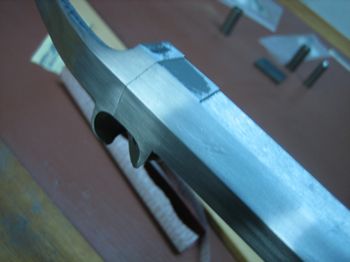
Next, the tang needs to be fitted to the hooked breech so that it is a snug fit with no lateral or vertical movement. You also want this seam to be barely noticeable. Tripp has done pretty well, but I've seen others do better.
There are other issues that arise because many of the pre-carve and 98% inlet kits of today were originally developed in the 1970's. Some of the molds for the metal castings have worn out and been replaced. Some of the master stock patterns have worn spots that cause inlets to be too large. And some metal castings aren't even available anymore.
Herb Troester has pointed out a problem with the current "Bridger" breech plug from Track of the Wolf. Ron Long originally designed this plug and made the molds around 1974. That mold must have worn out because the present tang castings are different. The tang comes off of the standing breech at an upward angle and needs to be bent down to avoid having a hump behind the breech. Then the tang must be straightened some to properly fit the wrist profile of the stock. The junction where the tang joins the standing breech has to be heated bright hot to do this. Herb says he has broken two tangs because he didn't get them hot enough.
Hopefully this picture better illustrates what I'm attempting to describe. A tang cast when Ron Long still owned the business is shown on the right and one of Track's recent tangs is on the left. The arrow points to the area that needs to be heated and bent down. Above that, the recent tang needs to be straightened to be more like the tang on the right.
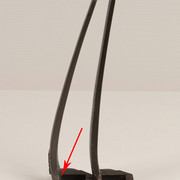
Following Tripp's sequence of photos, the next challenge is positioning the lock to fit the pre-inlet mortise and lining up the hammer nose to strike the nipple squarely. Once positioned the cutout in the lock plate for the breech bolster is marked and filed out.
Another area some people find difficult is fitting the entry pipe and nose cap. Tripp shows the process in his Images #17 through 19. The groove in the nose cap must line up with the entry pipe and both have to line up with the ramrod hole.
There are aspects of the trigger guard and the way it fits on the trigger plate that most people miss. In Tripp's Image #21, the trigger guard needed to be bent to bring the tip of the spur coming off the back of the bow up to where it almost touches the trigger plate as shown in these to photos of original Hawken rifles.
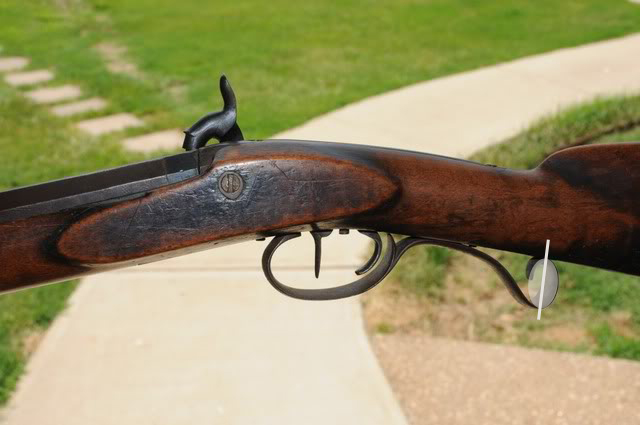
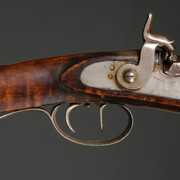
Tripp's trigger guard could have also been positioned a little further forward so the rear trigger is closer to the back of the bow as on the originals above.
Tripp doesn't show the process he used to fasten the under rib to the barrel. Traditionally, one can solder the rib on the barrel, use screws to fasten the rib on the barrel, or stake the rib on the barrel. Either of these approaches can be challenging for a beginner. The picture below shows either a screw or a stake in the barrel, the head of which has been peened into a recess in the rib.
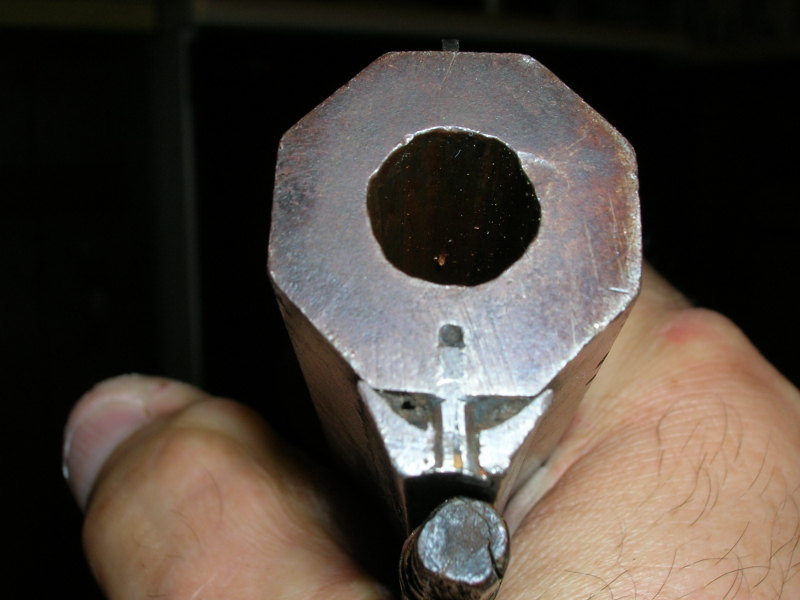
Soldering the upper ramrod pipes onto the rib isn't as straight forward as one might think. The correct way is to file a flat on the pipe and a corresponding flat area on the rib so the inside curvature of the pipe is in line with the groove in the rib.
These are the major issues that I can think of in building a half stock Hawken that one does not encounter when building a full stock flintlock Kentucky rifle. I'm sure I've missed some that others can add.
Thanks Phil! It does seem to be quite challenging. The TC kit, while far from an original Hawken anyway, had the breech and tang fitted quite well, so that challenge was eliminated. The stock inlets were also precise, so fitting the tang, etc. was pretty much a simple drop-in as I recall. It's been a few years, but the build was not at all challenging as far as I can remember. It was more of a matter of finishing wood and metal. Even the brass castings were already polished.
I know the "kits" from Track, Stith, etc. are more of a parts collection than a kit like the ones TC sold or even the Kibler offerings, which are true kits in my estimation. At this point, I'm just dreaming anyway. Between the expense of finishing the basement of our new-to-us home and the unexpected need to replace the power steering lines on my old F150 to the tune of $700, I'm going to have to be satisfied with tinkering on the guns I already have for some time.
Thanks again for your excellent reply. I'm sure I'm not the only one who was curious, so others will surely benefit from your answers.
I know the "kits" from Track, Stith, etc. are more of a parts collection than a kit like the ones TC sold or even the Kibler offerings, which are true kits in my estimation. At this point, I'm just dreaming anyway. Between the expense of finishing the basement of our new-to-us home and the unexpected need to replace the power steering lines on my old F150 to the tune of $700, I'm going to have to be satisfied with tinkering on the guns I already have for some time.
Thanks again for your excellent reply. I'm sure I'm not the only one who was curious, so others will surely benefit from your answers.




